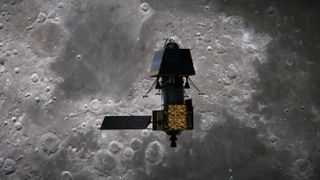- UID
- 20
- Online time
- Hours
- Posts
- Reg time
- 24-8-2017
- Last login
- 1-1-1970
|
|
━━━━━━━━━━━━━━━━━
More than one-third of attempts to land there have ended in failure.

In an artist's concept, the Indian lander Vikram nears the lunar surface.
▼ Space is hard. That was the takeaway on Sept. 7, when the Indian Space Research Organisation (ISRO) lost contact with its Vikram lunar landerduring an attempt to touch down at the moon's south pole.
India was poised to become the fourth nation to ever successfully touch down softly on the lunar regolith, doing so in a place that no other country has previously reached. Though the space agency is still scrambling to revive communication with Vikram — which has been spotted from lunar orbit— the unhappy landing sequence seemed like a painful echo of the situation earlier this year, when a private robotic Israeli lander, Beresheet, crashed into our natural satellite.
It's all a reminder that, despite the fact that humans landed on the moon many times during the Apollo missions half a century ago, doing so remains a tough business. Of the 30 soft-landing attempts made by space agencies and companies around the world, more than one-third have ended in failure, space journalist Lisa Grossman tweeted.
But why exactly is it so hard to land on the moon?
No one particular event is responsible for the many failed attempts, aerospace engineer Alicia Dwyer Cianciolo of NASA's Langley Research Center in Hampton, Virginia, told Live Science. To land on the moon, "so many things have to happen in exactly the right order," she said. "If any one of them doesn't, that's when trouble starts."
First, there's the matter of getting (▪ ▪ ▪)
► Please, continue reading this article here: Source |
|